So far in my newsletters, I’ve mostly discussed my research methods and shared some nice pictures of pots. This week, I thought I would take a moment to write about what I’ve been focusing on over the last few years.
In October 2022, the same month I finished my PhD, I was incredibly fortunate to receive a grant for a project at the University of Pisa. What started as a one-year post has now turned into a three-year research position, as we secured more funding for a new, related project. I am now a very happy postdoctoral research fellow at the University of Padova.
My main focus in these projects has been clay figurines, often unfired, from various archaeological sites in Egypt dating to the Middle Bronze Age (2100–1550 BCE). These figurines have been found in a range of contexts—domestic, funerary, and ritual—but the primary aim of the study is to understand what they can tell us about the everyday lives of people in ancient Egypt. These small, often unassuming objects typically originate from household buildings or rubbish dumps. They are usually either anthropomorphic (human) or zoomorphic (animal) in form. We find anatomically detailed male and female figures, as well as others that are depicted as just a torso with no arms or legs. Similarly, there are extremely intricate animal figurines—a bull with horns or a crocodile with scales and teeth—while others are simple enough that you can just about discern that it is an animal with four legs.


So, what is my role in the study of these fascinating artefacts? As you might expect, I am examining the clay and how these figurines were made. For obvious reasons, we cannot cut these beautiful figurines up to look at them under a microscope. Instead, I am analysing their chemical composition using a method called portable X-ray fluorescence (pXRF). I will go into more detail about this method in another post, but generally, we use it to determine the elemental composition of the artefacts. This allows us to see which figurines were made from the same or similar clays and which were not. We can also compare this data with geological samples to try to pinpoint where the clay originated.
A recent example of where geochemical composition methods have been used to great effect in archaeology is the analysis of the altar stone at Stonehenge. In a paper published in Nature in August, researchers demonstrated that instead of the stone originating from more local sources (near Marlborough) or the Preseli Hills in Wales—where the smaller bluestones are from—the data indicates it was brought from at least 750 miles away, in northeast Scotland (you can read more about this in the BBC Article).
This knowledge can significantly change and deepen our understanding of the site in several ways. It shows that the site's importance extended far beyond its immediate region and reveals the tremendous effort taken in transporting a large, heavy object over such a great distance. This undertaking suggests that people dedicated considerable time and effort to this task, and indicates a higher level of connectivity among the communities living in Britain during the Neolithic period than previously assumed.


While I did not expect my results to show the figurines were made in locations far away from where they were found, I am starting to get some intriguing results. I am extremely happy to say that my results from the analysis of a small group of figurines from the site of Lisht have been published this week in a special issue of Middle Kingdom Studies.


I will aim to write a proper article about what I found in the next few weeks.
What I did this week:
This week I spent a great day at the Petrie Museum on Monday, gathering some final data on the anthropomorphic and zoomorphic figurines from the site of Lahun - a workman’s town associated with the nearby Pyramid of Senusret II. It is always so nice to work in the Petrie museum as I have been going there since I was an undergraduate student in 2008. It is also such a privilege to be able to work with such incredible objects, it is not something I ever take for granted. To be holding an object made and used by someone living thousands of years ago, never ceases to bring me joy.
Unfortunately, I don’t have time to write a longer post this week as I have an important fellowship application due. But if you would like to see and read more about the projects I have been part of in Pisa and Padova, here are a few links: PIPE Website PIPE - Uni Pisa PROCESS Project




